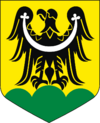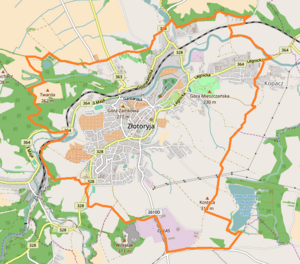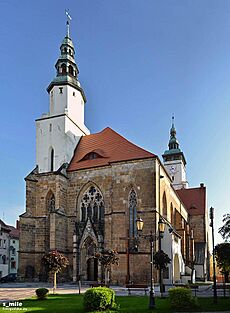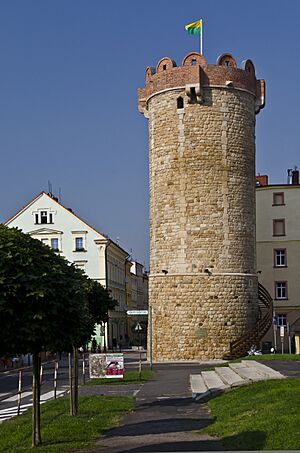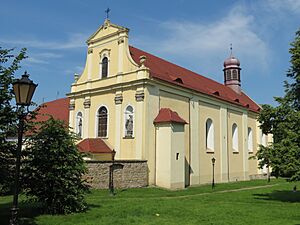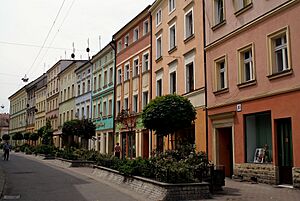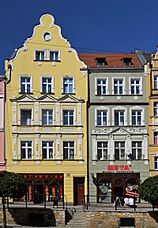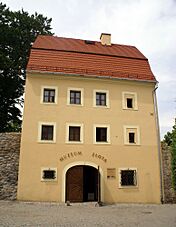Złotoryja facts for kids
Quick facts for kids
Złotoryja
|
|||
|---|---|---|---|
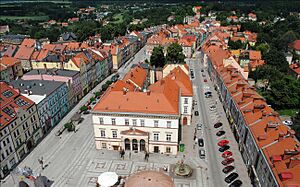
View of Old Town and marketplace
|
|||
|
|||
| Nickname(s):
Stolica Polskiego Złota
Capital of Polish Gold |
|||
| Country | |||
| Voivodeship | Lower Silesian | ||
| County | Złotoryja | ||
| Gmina | Złotoryja (urban gmina) | ||
| Established | 12th century | ||
| Town rights | 1211 | ||
| Area | |||
| • Total | 11.51 km2 (4.44 sq mi) | ||
| Population
(2019-06-30)
|
|||
| • Total | 15,564 | ||
| • Density | 1,352.2/km2 (3,502.2/sq mi) | ||
| Time zone | UTC+1 (CET) | ||
| • Summer (DST) | UTC+2 (CEST) | ||
| Postal code |
59-500 to 59-501
|
||
| Area code(s) | +48 76 | ||
| Car plates | DZL | ||
| Voivodeship roads | |||
| Website | http://www.zlotoryja.pl | ||
Złotoryja (pronounced zwah-toh-REE-yah) is a historic town in southwestern Poland. It's located in the Lower Silesian Voivodeship. Złotoryja is special because it was the first town in Poland to be given "town rights" in 1211. This meant it could govern itself more.
For a long time, Złotoryja was famous for mining gold and copper. People even called it the "Capital of Polish Gold." Today, it's known for its beautiful old buildings and lovely location.
Contents
Geography and Location
Złotoryja is in the historic Lower Silesia region. It sits on the right side of the Kaczawa river. The town is about 20 km (12 mi) southwest of Legnica. To the south, you can see the Kaczawskie Mountains. These mountains lead up to the Karkonosze range.
Today, Złotoryja has about 16,000 people. It's also an important place for mining basalt, a type of rock.
What Złotoryja Means
Złotoryja has had many names over time. In Latin, it was called Aurum (meaning "gold") or Aureus Mons ("Golden Mountain"). In German, it was Goldberg, which also means "Golden Mountain."
The Polish name, Złotoryja, literally means "gold-digging." This name comes from the town's history of people searching for gold in the Kaczawa river.
Town Symbols: Coat of Arms and Flag
The town's coat of arms shows a black eagle. This eagle represents the Silesian Piasts, a powerful family that once ruled the area. The eagle stands on three green hills, all on a golden background. This design has been used since the 15th century.
The flag of Złotoryja uses the same colors as the coat of arms. It has two stripes: a golden (yellow) stripe on top and a green stripe on the bottom.
A Look at Złotoryja's History
Early Beginnings and Gold Mining
Long ago, in the early Middle Ages, a Polish tribe called the Trzebowianie lived here. By the 10th century, this area became part of the new Polish state.
In the late 1100s and early 1200s, a small group of gold miners settled near the Kaczawa river. This village grew quickly. In 1211, it was officially named Aurum and given "town rights" by Duke Henry I the Bearded. This made Złotoryja the very first town in Poland to have these special rights! Henry I also helped build St. Mary's Church, which is still a famous building in town.
In the 1200s, two monasteries were built here. This made Złotoryja an important place for culture and religion. In 1241, many miners from Złotoryja fought in the Battle of Legnica against the Mongols. Many of them died, but gold mining soon started again.
Later, in 1290, the town got the right to trade salt. Salt was a very valuable mineral back then. In the 1400s, during the Hussite Wars, Złotoryja was attacked several times. After these attacks, the town decided to build strong city walls to protect itself. Many parts of these old walls are still standing today!
Changes and Challenges
By the early 1400s, most of the gold was gone. But Złotoryja found new ways to make money. It was on an important trade route called Via Regia, which connected big cities. The town also started making beer and weaving cloth.
In 1504, a school was opened. Later, in 1522, it became a special school called a Latin gymnasium. This was the first of its kind in Silesia. A famous teacher, Valentin Trozendorf, even wanted to turn it into a university!
In 1526, Złotoryja became part of the lands ruled by the Austrian House of Habsburg. The town continued to do well until 1608, when a big flood caused a lot of damage. Five years later, in 1613, a huge fire destroyed many houses. It took almost 100 years for Złotoryja to fully recover.
In 1742, the town became part of the Kingdom of Prussia.
Modern Times
During the Napoleonic Wars, in 1813, a big battle happened near Złotoryja. The French army was defeated by Prussian forces.
In the late 1800s, Złotoryja started to grow again. In 1884, a railroad connected it to Legnica. More train lines were built later. People tried to find gold again, but it didn't work out. Instead, copper mines were opened, but they faced problems in the 1920s.
World War II and Today
During World War II, the Germans set up prisoner-of-war camps and forced labor camps in Złotoryja. Many prisoners, including Poles, French, and Italians, were held there. In February 1945, the town was captured by the Soviet army.
After the war, Złotoryja became part of Poland again. Most of the German residents left or were moved out. The town was renamed to its historic Polish name, Złotoryja.
In the 1970s, copper mines nearby closed down because better ore was found elsewhere. However, new factories opened in Złotoryja, including a shoe factory and a Christmas tree ornaments factory.
Since 1989, Złotoryja has worked to bring back its history. The old town has been fixed up. In 1992, a group called the Polish Guild of Gold Prospectors started. They organize the Polish Gold Panning Championships every year! In 2000, the World Championships were even held here.
Today, Złotoryja is a popular place for tourists. Its quarries (places where rock is dug out) are very successful. The Christmas tree ornaments factory sends millions of ornaments around the world each year.
Main Sights to See
- Market Square (Rynek): This is the main square, surrounded by beautiful old buildings and the Town Hall.
- St. Mary's Church: This church was built in old Romanesque and Gothic styles. Duke Henry I the Bearded helped start it. It's the most important historic building in Złotoryja.
- 14th-century city walls: You can still see parts of the old walls that protected the town.
- Blacksmiths Tower (Baszta Kowalska): A well-preserved tower from the old city walls.
- St. Hedwig's Church: Another historic church in the town.
- Holy Cross Church: Also known as St. Nicholas's Church.
- Fountains: There are several interesting fountains around the town.
- Gold Mining Museum: Learn all about Złotoryja's gold mining past here. It used to be called the "Gold Museum."
- Wilcza Góra reserve: A natural area nearby.
Famous People from Złotoryja
- Valentin Trozendorf (1490–1556): A Protestant teacher and thinker.
- Wilhelm Gliese (1915–1993): A famous astronomer (someone who studies stars and planets).
- Mariusz Szczygieł (born 1966): A well-known journalist and writer.
Sister Cities
Złotoryja has "sister city" relationships with other towns around the world. This helps them share culture and ideas.
See also
 In Spanish: Złotoryja para niños
In Spanish: Złotoryja para niños


